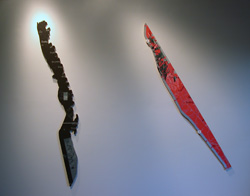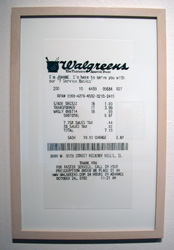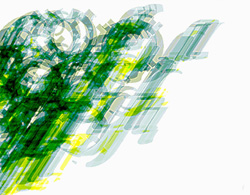
|
||
|
Portland art blog + news + exhibition reviews + galleries + contemporary northwest art
|
||
Maintain Full Speed
The Affair is less than 24 hours away, which means that September has sadly passed and we are launching into yet another overactive month in October. Before we let September slip away entirely, a quick revisit of one of September's standout shows, Inertia 2005 at Gallery 500, an exhibition of 13 artists from across the United States, juried by PORT's very own hyperactive curator, Jeff Jahn. The premises of the exhibition was to dig up new talent from across the nation, and as a result work runs the gamut, from conceptually-oriented work to pieces driven primarily by good design. Thankfully, the pool of over 100 artists who submitted work for the show was narrowed down to a mere 13 artists, avoiding the mistake of other group shows I've seen at Gallery 500, where an exuberance for the maximal tends to result in cramped installations. There is no mystery as to why Tudor Mitroi's staffs, painted panels cut into long, thin shapes, appeal to Jahn, who makes medium sized painted panels cut into irregular lightning bolt shapes. Mitrol's works are large, yet have a sense of delicacy difficult to achieve at such a large scale. His two staffs show painted details of maps that outline different courses, one that seems to be a walking route of some sort, the other a driving route that the artist used daily to travel between home and work. One side of each panel is cut to follow the route. The shapes look awkwardly thin, yet threatening, like jagged weapons. They also serve as documentation of the artist's journeys, adding a performative aspect that recalls work by artists like Richard Long. John Mueller challenges the notion of documentation in Subterfuge, an opaque black bottle housed in a vitrine atop a flawlessly crafted black pedestal. Alongside the black bottle is another museum-like display with a lit x-ray that reveals a play on the ship-in-a-bottle trick. The viewer's complete experience of the object hinges on his or her willingness to believe the artist's documentation. It's an issue with many implications, especially as performance art has created a genre in which one is often forced to experience the piece based solely on documentation. Tom Friedman's 1000 Hours of Staring, a blank piece of paper that the artist has purportedly stared at for the given number of hours, is probably my all-time favorite piece that deals with the issues of fact vs. fantasy and trust between the artist and viewer.
Joseph Lupo, who garnered best of show, and Kristin Skees, who has gained much praise on the street and in the press, both presented formally successful pieces, but I couldn't shake a feeling of deja vu looking at their work. Lupo's oversized receipts, painstakingly reproduced by hand from actual receipts, form a kind of arbitrary biography of the mundane details of the artist's life. Each receipt is convincingly rendered in familiar tones of faded purple and black. They work, but Brooklyn-based artist Ester Partegas created oversized, hand-drawn receipts for her Details series, which I saw in 2002 at apexart in New York. Partegas uses oversized bits of tape to attach her receipts casually across the gallery wall, complete with crooked folds that suggest these bits of paper were once shoved into a back pocket or rescued from the bottom of a purse. As likeable as Lupo's work is, his decision to frame his receipts gave them a heavy-handed aspect that contributed to the fact that I never could quite get over the nagging thought that Partegas did this kind of work better several years ago. It was strong work, just too close to the earlier work of a more established artist, and I'll be curious to see what Lupo presents in his upcoming solo show, which he earned as part of his best of show prize. Kristin Skees' knitted red Tool Cozies, which lovingly caress the hard metal surfaces of drills, screwdrivers and staple guns, serve as an updated take on feminist art, with an appropriately crafty bent very fitting for 2005. The piece doesn't parse gender stereotypes with any degree of sophistication, but if that's the point, then it's very successful as a kind of shallow and cynical take on what it means to create feminist art right now. One of my former professors at Lewis & Clark, Phyllis Yes, was very sincerely questioning gender stereotypes by "feminizing" objects from the toolshed decades ago. Skees' work can't be sincere, and so it works best as a second-generation feminism that ambiguously rests between a statement on gender and a critique of art about gender. A photograph of a man in a red knitted "Husband Cozy" works better than Skees' actual objects, perhaps because it doesn't toe the line of sincerity quite so closely.
Other notable works in the show include Brian Lemond's wall pieces, which uses wood grain to form repeating geometric surfaces. Similar to Elizabeth Blade's illuminated screen and Josh Feldman's excellent digital prints, Lemond's pieces seem to offer little more than really great design sense, but in this case, that's enough. Ken Turner's Blue Door Yo-Yo, comprised of a series of photographs of a woman performing what appears to be a traditional Asian fan dance with a man completing an elaborate yo-yo routine, hinges on formal resonance to explore interactions between high and low performance. Patrick Rock, who is gaining new notoriety around town for his big bouncy wiener at Fresh Trouble, presents two videos, once of a red ball bouncing at surprising speeds along a desert floor, the other a repeating Naumen-esque scenario of a disheveled man opening a beer on top of a Styrofoam cooler before it breaks, again and again. Inertia 2005 offers an eclectic group of work, no doubt fulfilling its aim of bringing a roster of new names and solid young talent to Gallery 500. Posted by Katherine Bovee on September 30, 2005 at 8:27 | Comments (3) Comments I have never doubted that Friedman really did spend 1,000 Hours of Staring at that piece of paper. So, for me, it isn't really about trust, fact, fantasy, etc. Rather, I take it as a statement that share effort & process isn't enough, that the result matters too. One thousand hours is quite a bit of time--forty hours a week for half a year. However, Friedman spent three years on the piece, which works out to a bit less than an hour a day. I like to think he spent the time meditating rather than simply staring. Posted by: SimEnzo Oops, make that sheer effort. Posted by: SimEnzo Because Friedman's work is so exacting, I didn't ever doubt that he actually spent 1000 hours in front of this piece of paper either. However, he purposely avoided providing documentation that would somehow provide evidence, which I think is very significant. I think of 1,000 Hours of Staring as more of a byproduct Friedman's studio practice than a manifesto of the importance of result. Call it staring or call it meditation, but the act of looking is very important for Friedman. In the excellent Phaidon monograph on Friedman, he recounts a pivotal time at graduate school, when he cleared out everything from his studio, boarded up the windows and painted everything white. He stopped trying to make art, instead using his studio as a space in which he would bring in objects one at a time to spend hours looking, thinking, considering this object in a pristine space. I think this type of studio practice is why he is able to reconceptualize objects in a very elemental way. Katherine Posted by: keuro Post a comment Thanks for signing in, . Now you can comment. (sign out)
(If you haven't left a comment here before, you may need to be approved by
the site owner before your comment will appear. Until then, it won't appear
on the entry. Thanks for waiting.)
|
| s p o n s o r s |
 |
 |
 |
 |
 |
 |
 |
 |
 |
 |
 |
 |
 |
 |

|
Site Design: Jennifer Armbrust | • | Site Development: Philippe Blanc & Katherine Bovee | |





![[TypeKey Profile Page]](http://www.portlandart.net/nav-commenters.gif)